AC-Aero USA LLC
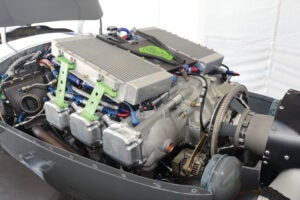
Longtime freelance engine designer Andy Higgs joined with businessman and Reno racer Karl Grove last year to form AC-Aero. Their goal: introduce new, non-certified engines with modern cylinder designs and increased displacements. Performance and efficiency were preeminent; affordability was down the list, so the result was some distinctly handsome, but not inexpensive hardware.
Two very separate engine lines were developed. The first uses new AC-Aero water-cooled cylinders joined to Lycoming cases and a second, more radical, completely new HIGGS family of engines is built around a unique combination of two- and four-stroke technologies, burning Jet A and organized into a wide variety of engine layouts.
A year on, says Grove, the liquid-cooled AC-Aero cylinder banks—and the engines built around them—are in production and have been sold in complete engine form. The very different HIGGS engines are promised in Q1 of 2022; they’re listed in the Diesel section of this guide.
Here we’re covering AC-Aero’s liquid-cooled cylinders for four- and six-cylinder Lycoming architecture engines. They include the Legion stroker kits, which use a longer stroke crankshaft to gain engine displacement (409 inches for four cylinders, 613 cubes for six cylinders).
The liquid-cooled cylinders are the four-cylinder Gladiator and six-hole Centurion. These are completely new cylinder bank designs, configured to run on standard Lycoming bottom ends. In other words, they turn a Lycoming into a liquid-cooled engine. Naturally, the AC-Aero cylinder design features a much more modern combustion chamber along with a displacement increase compared to stock Lycoming fare. When the Legion stroker kit is combined with the liquid-cooled cylinders, you end up with the Gladiator X440 four-cylinder and Centurion X660 six-cylinder engines. Yes, the numerals denote the resulting large cubic-inch displacement, which gives an idea of the power potential based on simple displacement alone.
Advantages to the new liquid-cooled cylinder banks are an advanced combustion chamber, tighter piston and piston-ring tolerances for more power and less oil consumption, elimination of shock cooling, along with less weight compared to air cooling (yes, including the coolant, radiator and so on, says Grove).
AC-Aero uses a service center approach to sales and service. The first of these is Aircraft Service and Parts Corporation in Bakersfield, California. Customers can fly in to ASAP for turnkey installations as they are located at Bakersfield Municipal Airport. The best advice is to communicate with AC-Aero or ASAP directly as an amazing number of combinations and possibilities are on offer, from starting with rebuildable Lycoming cores to all-new engines. Furthermore, Andy Higgs lives in Japan and uses Japanese foundries and machining, so there can be a wait for the next batch of parts.
BRP Rotax
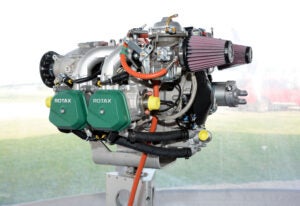
A division of Bombardier, Rotax is based in central Austria (think castles, not kangaroos), where it builds engines for the greater BRP empire including all sorts of light recreational vehicles such as side-by-side utilities, boats, personal watercraft, snowmobiles, motorcycles and light aircraft. Therefore, Rotax is a larger engine maker than it might seem at first, with first-rate production facilities and engineering. Rotax has been the largest-volume engine maker in general aviation for quite a while, and by a large margin. They are seriously involved in light aircraft engines and intend to maintain their number one position.
In the United States Rotax is mainly represented by Lockwood Aviation Supply in Sebring, Florida, and California Power Systems (owned by Aircraft Spruce) in Corona, California.
Unfortunately, the only Rotax news for 2022 is after holding the line on pricing last year, they’ve upped the price of admission somewhat over 4% this year. The entry-level 912 UL thus moves to $17,258 while at the other end of the line, the turboed 915 iS has crossed the $40,000 barrier for the first time at $40,353. Like other European engines, pricing changes with the euro-dollar relationship, so double-check when ordering.
So, the 912, 914 and 915 series engines continue mechanically unchanged. These relatively lightweight and compact engines use air-cooled cylinders and liquid-cooled cylinder heads and are designed for higher rpm than big-bore Lycomings and Continentals. Therefore they all include a built-in spur gear propeller speed reduction unit (gearbox) to optimize propeller rpm. All have dry sumps and use hydraulic valve lifters. Carburetor or electronic fuel injection are offered depending on the model, and some are turbocharged.
Still the best-selling Rotax is the carbureted 912 series, available in 80-hp form as the 912 UL or with 100 hp as the 912 ULS. The 80-hp version is most popular in Europe; the 100-hp variant remains the number one seller in the United States. Part of their European heritage perhaps, but Rotax engines do best on unleaded mogas because the lead in 100LL eventually accumulates as sludge in the gearbox.
Rotax offers two turbocharged engines, the carbureted 914 and their newest powerplant, the 915 iS, which is entering its fourth year of production. The latter is definitely spendy but offers the best power-to-weight ratio in its class, along with a meaty 141 takeoff and 135 continuous horsepower up to 15,000 feet for excellent mid-altitude performance. By comparison, the 115-hp 914 will save you about $7000 by retaining carburetion in lieu of fuel injection, plus the 914 has a TBO of 2000 hours compared to the 915’s 1200 hours. Yet better horsepower-per-dollar is found with the 100-hp 912 ULS, which greatly explains its popularity.
While not an overwhelmingly widespread option but worth exploring in the face of rising prices, Rotaxes have been around long enough that used and rebuilt examples are out there. Lockwood reports shipping two overhauled Rotaxes a month from their affiliate, Lockwood Engine Repair, for example.
Continental / Titan
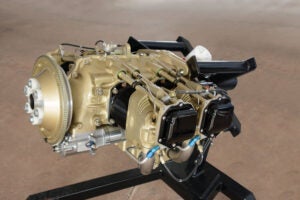
For a large, established engine maker, Continental has long been adventurous. They engineered and put on sale the definitely superior liquid-cooled Voyager series in the 1980s and have had a knack for such premium features as tuned intake systems. Later they added their current stable of certified Jet A piston engines, and when the RV onslaught drove the Lycoming four-cylinder architecture to prominence, Continental wasn’t too proud to develop their upgraded version of those engines.
As a result, today Continental offers an engine for just about any general aviation airframe. Their certified engines are necessarily expensive, but in big-bore IO-550 form provide the basis for the big sixes favored by fast Lancair builders. Typically those engines are either appropriated direct from salvage yards or built to suit by custom engine shops, so we have not listed these popular engines in the specification charts.
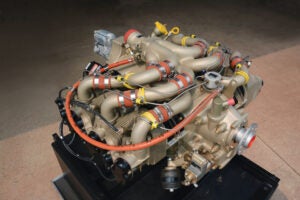
Likewise Continental’s investment in Jet A piston engines is too expensive for kit builders. These engines are best suited to the new and re-engined certified crowd that needs Jet A fuel outside of the U.S. where 100LL is too dear or impossible to find.
Where Continental shines for us Experimental/Amateur-Built types is with their Titan brand engines. These replicate Lycoming architecture but with numerous upgrades. These are Experimental derivatives of four-cylinder Lycoming parallel-valve architecture engines in the popular 340 and 370 displacements; power ratings range from 174 to 195 hp.
To reduce the incredible parts count possible in this engine series, for 2022 Continental has decided to pause the stock-stroke 320 and 360 Titan production in order to concentrate on the 340 and 370 stroker variants. Sadly, the Titan version of the 540 is also paused for the same reason.
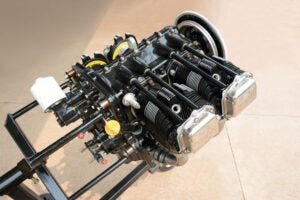
The remaining Titans still come stock with upgrades not available elsewhere. For example, Titan sumps/intake manifolds are a magnesium version of the traditional “hot sump” casting, saving a meaningful 7 pounds. Optional sumps are either Titan’s vertical or Superior Air Parts’ cold-air intake with a forward-facing throttle body inlet. There is no forward-facing hot sump or rear-facing sump of any kind on Titan engines.
Titan engines also feature steel insert crankshaft thrust washers. The original design takes thrust loads directly by the parent aluminum of the case, which can gall if run hard before fully wetted during break-in or under very hard loads or extreme time in service. Titan machines their cases to accept the steel thrust washers first seen in Continental 470/520 engines to essentially eliminate this issue.
All Titan engines are statically and dynamically balanced, plus use roller valve lifters. Titans allow front or rear propeller governors as the customer specifies, as well. Also stock is Continental’s nickel-carbide cylinder treatment (NiC3) for a definite upgrade in durability and corrosion resistance. That also allows a 5-year warranty against cylinder barrel rusting on all Titan engines along with their normal 2-year or TBO warranty on the rest of the engine assembly. Warranties begin when the engine is put in service, not to exceed one year after purchase. TBO is 2000 or 2400 hours.
The Titan line also offers an extensive line of optional equipment. All Titans have electronic ignition of some sort, so no upgrade is needed there.
D-Motor
Hailing from Belgium is the D-Motor, notable for its simple flathead (yes, flathead) layout. The innovative idea is to have a relatively large displacement, mechanically near-primitive engine for reduced weight, cost and package size (it’s very narrow), but coupled with modern electronic engine controls. The original intent was for a small helicopter fitment, with light aircraft following.
Four engines are offered. They’re split between four- and six-cylinder, either naturally aspirated or supercharged via belt-drive Rotrex centrifugals. All sport dual electronic ignition and electronic fuel injection along with Nikisil treated cylinders for good corrosion resistance. The result is a commendably compact package ranging between 95 to 180 hp that fits nicely in larger ultralight and Light Sport aircraft. D-Motor engines are distributed in North America by Dave Hertner at Fisher Flying Products in Ontario, Canada.
The catch with D-Motor is pricing. The engines are in production and available from Fisher, but changes in D-Motor management during COVID resulted in a major price increase, such that the entry level LS26T 95-hp engine is a bit under $35,000, and the range-topping supercharged six-cylinder LS39ST retails for $64,673 at the exchange rate current at our deadline. That’s pricey for 150 continuous horsepower, so sales have been minuscule in North America.
Edge Performance
Taking up where Rotax leaves off is Edge Performance, with headquarters and engineering in Norway and dealers worldwide. The North American distributor is Jason Busat, doing business as BadAss Powersports in Lacombe, Alberta, Canada. The U.S. dealer is Michael Busenitz at STOL Creek Aviation in Whitewater, Kansas. Their market is mainly hot STOL sport and competition aircraft.
Using factory-new Rotax components combined with Edge parts, customer engines are built by dealers to Edge specifications. The number of combinations possible, along with the increased performance and often reduced weight, is impressive. As expected, big-bore kits are especially good sellers.
Three of Edge’s four Rotax-based powerplants—one naturally aspirated and two turbocharged—deliver much of what the hot Rotax market is after. Of the two NA options—the EP915ECi and 916ECi big bore kit—the former is the simplest and least expensive. It’s essentially a 912ULS Rotax fitted with a 1484cc big-bore cylinder kit and Edge fuel injection to deliver 120 hp while saving about five pounds. Busenitz says the fuel injection really transforms the engine, helping to noticeably smooth the idle, quieting the PSRU so it doesn’t sound so much like a box of rocks, plus it gives faster throttle response and typically a one gallon per hour better fuel burn. As for the 916, it uses larger cylinders yielding 1621cc but requiring case and head machining, so it’s more expensive and mainly seen as a big bore kit rather than a complete engine.
Being naturally aspirated big-bore models, the 915ECi and 916ECi are popular in airframes with bed-type engine mounts because there is no turbo to get in the way.
Imagine Rotax’s carbureted, turbocharged 914 engine, but with fuel injection and you have Edge’s most popular engine, the EP914Ti. It’s rated at 125 hp and is built from a Rotax short block fitted with the low-compression 80-hp cylinders from the 912 UL. It’s an easy engine for a dealer to assemble as all they really need to do is dress the Rotax long block with their turbocharger, exhaust and Edge’s EFI fuel injection. As a result, STOL Creek can sell it for less than the 914 Rotax.
Topping the Edge line is the turbocharged 912STi, comparable to the Rotax 915, except it weighs 25 pounds less, has more boost and thus jumps to 154 hp all while retailing for about $1500 less. It is built starting with a 912 ULS short block.
Other pluses are the Edge electronic fuel injection is tunable by the customer or via the internet by Edge to include injector trimming for extra-close EGTs, Edge’s intake manifold features equal-length runners, plus they also offer their parts as conversion kits for existing Rotax owners wanting to warm up their engines.
We’re listing STOL Creek’s general Edge engine prices in the specification tables, but Busenitz notes fluctuations in the exchange rate plus Rotax pricing adjustments mean these often change. He says it’s best to call and get a quote when you’re ready.
There is an Edge warranty. To simplify, everything is covered for one year, then four additional years on the non-Rotax parts. TBO remains the same as stock Rotax other than the 912STi, which is 1500 hours until Edge has more experience with it.
Finally, Edge sells other than Rotax-based engines. One of these, the racy EPeX300Ti gets attention thanks to its 300-hp rating. It’s built off a Yamaha Apex liquid-cooled inline four-cylinder and is doing well in the STOL racing world. But Busenitz suggests letting the racers put a few more hours on it before putting it in general sport service.
HKS
Two-stroke engines, once the staple of the burgeoning ultralight craze, have almost all faded from the scene. But the time-tested HKS 700E two-cylinder remains available worldwide through Quicksilver Aircraft Northeast. Rated at 60 hp for 3 minutes and 58 hp continuously, the opposed two-cylinder is built by one of Japan’s pioneering tuning houses and can be found both on ultralights and very light sport aircraft. Buyers can choose between two gear ratios in the integral spur-gear propeller reduction box and expect a 1000-hour TBO. Bucking the trend this year, HKS pricing is unchanged; the basic engine is $11,800, rising to $13,656 when fully dressed with its dry-sump oil tank, oil cooler and throttle cable.
Jabiru
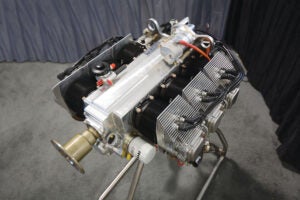
Light weight, simplicity, affordability and a snappy power-to-weight ratio are Jabiru defining characteristics. On sale for many years—the company was founded in 1988—the Australian engine has also gone through several rounds of development. Now in its fourth generation, the engine is delivering the sort of accessible power its simplicity has always promised.
Much serious development went into the Jabiru’s cylinder heads to improve cooling, and with those worries banished the fourth-gen Jabiru has continued unmodified the last few years, including 2022. Construction is heavy on aluminum through the crankcase and cylinders—silicon carbide and nickel coated—for low weight and rapid heat transfer. Jabiru has the parts mainly constructed by specialist machine shops in South East Queensland and South Australia, then assembles them in their own in-house facility before shipping U.S.-bound units to Arion Aircraft in Shelbyville, Tennessee. Demand is good and with the long supply chain, this means over a half year’s wait, said Arion at our deadline.
After a half decade of stable pricing, Jabiru has joined the chorus of rising costs this year. Arion has absorbed some of the raise themselves and passed on the rest in somewhat higher retail pricing. They also have a builder assist program and are the only shop doing major Jabiru overhauls in the U.S.
Two engines are offered, a four-cylinder 2200 rated at 80 hp and a six-cylinder 3300 rated at 120 hp. Both are popular but the 3300 outsells the 2200 around 10:1 according to Arion. The 132-pound 2200 is found in smaller Zenith and Sonex airframes, RV-12s and Titan Tornados; the bigger 3300 is typically seen in larger Zenith airframes and Arion, RANS and Sonex models.
Both are simple engines. A single Bing slide-type carburetor, mechanical fuel pump and inductive ignitions are used along with fixed-timing ignition distributors. Both the alternator and inductive ignition are integral to the engine and both should be working as long as the engine is rotating. Arion says they are “really enjoying these engines. There’s not much to do to them, just oil changes and off you go.”
Lycoming
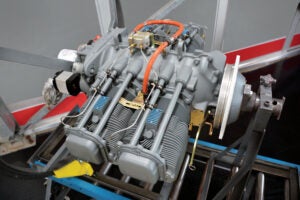
Incremental improvements is engine giant Lycoming’s news for 2022. The overall engine line-up is unchanged—nothing unexpected in that—but in their continuing move away from magnetos, all four-cylinder Lycomings now wear a pair of electronic ignitions as standard. The six-cylinder engines should eventually do the same, but the dual e-ignition versions were in testing at our deadline with no word on when they would make the move to production.
Otherwise Lycoming reports the 390 angle-valve stroker, “is selling like hotcakes” as the market looks to muscle up the four-cylinder platform for all it’s worth. Of course, the 540 and its derivatives are selling too, but as the workable airframes for that much engine (and expense) are understandably more limited, the six cylinders come in second in the sales reports. So, from grocery getter to competition aerobatic thrust, Lycoming has the market covered starting with their 118-hp YO-235 and ending with a 315-hp injected YIO-580 angle valve derivative of the 540.
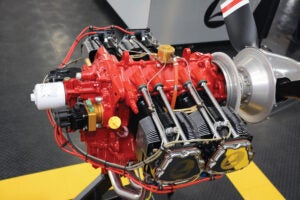
As for supply chain issues, Lycoming says they occasionally arise, but they seem to have accepted such inconsistencies as part of doing business today. Thus, they report no systemic issues delivering product although our advice remains to research and order early. Certified Lycoming-branded engines typically have an approximate two-month lead time while the Experimental, custom-built Thunderbolt line is experiencing five to six months between ordering and delivery.
In case you’re new to the Thunderbolt brand, it is literally its own special space within the expansive Lycoming factory in Williamsport, Pennsylvania. Certified engines travel down Lycoming’s regular production line while in the Thunderbolt shop small teams build engines for the Experimental market. The idea is to offer a premium engine, along with an extensive line of custom touches for increased power or appearances. Therefore, Thunderbolt engines carry a price bump over stock but include balancing to tighter tolerances, cylinder head porting for easier breathing, your choice of Airflow Performance or Avstar constant-flow mechanical fuel injection, Lycoming’s EIS electronic ignition, dynamometer break-in and a fair number of paint color choices in lieu of Lycoming’s usual monotone gray treatment. From there the options are nearly limitless, including many more colors, chrome detailing, high-compression pistons and so on. The most common option in Thunderbolt engines is compression bumped to 10:1, with the caveat that 100LL fuel is then required (no mogas).
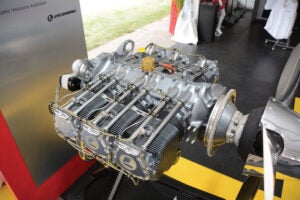
As for the engines offered, Lycoming lists their familiar O-235, 320, 360, 390, 540 and 580 cubic inch designs in their Thunderbolt lineup. That’s every Lycoming save the eight-cylinder 720, which can still be had as a certified engine if you really need that much oomph. Of the engines offered, all use parallel valve cylinders except the 390 and 580, which employ angle-valve cylinder heads. That makes them more efficient and powerful, but also heavier and more expensive.
And as we note every year, to put things in perspective Lycoming holds one major trump card in the time-tested nature of their powerplants. There are so many Lycs flying the company estimates the Lycoming brand accrues 1 million fleet hours monthly. That’s a bunch and also shorthand for saying Lycomings are the most understood and easiest to get serviced engines in general aviation today.
MWfly
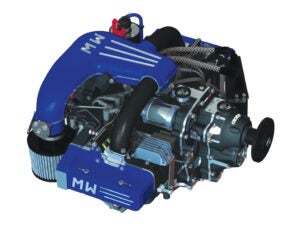
If Rotax is the established leader of the newer, smaller-displacement aircraft engines, then ULPower and Italian engine manufacturer MWfly might be thought of as the Rotax alternatives.
While all three of these companies offer relatively smaller, higher-rpm engines than the traditional big-inch Lycomings and Continentals, MWfly has uniquely chosen to maximize the strategy via 100% liquid cooling and a choice of adding a PSRU gearbox. Thus, these overhead cam engines happily turn more rpm for more power (most MWfly engines spin 4000–4500 rpm at takeoff) while the propeller stays slower, increasing its efficiency and reducing noise. Tighter internal clearances and lack of shock cooling are other advantages; placing the modest radiator is an extra chore in air-cooled cowlings.
There are no carbureted MWfly engines. Electronic ignition and fuel injection with dual ECU computers are standard at no extra cost at MWfly. That’s unique in the segment, save, perhaps, D-Motor.
Of course, MWfly is hardly a household name with U.S. airport bums, but that might be changing. The company has been shipping engines since 2013 (about 300 to date), with approximately 100 examples flying in Europe, plus the company continues showing vitality. Taking advantage of the 2021 COVID downtime, MWfly moved into a larger manufacturing facility in Milan, significantly revised their engines and brought Nick Dawson in as their new North American distributor. He’s in Wentzville, Missouri, as MWfly U.S. LLC.
The engines are now organized under two general headings, the blue painted SKYline for cruising and the red painted REDline for performance. The physical differences between them are few and more typically found in the computer software for more rpm and power. Just for the record, the earlier BT22 and BT25 engines were all painted black and are no longer in production. Like the older engines, the new versions are all available in left- or right-hand rotation should you have a pusher application in mind.
Inside, the previous roller-rod bearings have been replaced with plain bearings, the crankshaft has been redesigned for increased strength and the intake manifold is new. These engines were in assembly at our deadline and scheduled to go on sale in December 2021.
Dawson reports firewall-forward kits are available for most Zenith 650/750s plus a couple of Sonex models, with the Just Aircraft Highlander next to be developed as interest from the STOL community is picking up. He also prefers to keep general pricing information in euros until it’s time to provide a custom quote as the exchange rate fluctuates. He notes the MWfly engines typically end up running between $23,000 and $27,000 depending on the model, with accessories around $3500 for a total cost of $30,000 or a bit more.
Finally, the 135- and 160-hp direct drive engines garner much attention but are high-rpm units for helicopter use only and can’t be used in fixed-wing applications.
Superior Air Parts
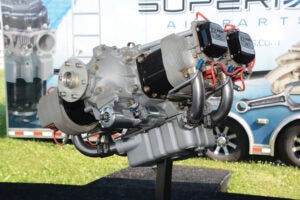
It’s mixed times at longtime engine parts manufacturer Superior. The company’s extensive line of Lycoming aftermarket engine parts is vital to the industry as they sustain a ready supply of parts to the engine rebuilders (and sometimes original manufacturers) where they are popular. Just as important to all of us, Superior’s extensive parts catalog keeps everybody’s retail prices in check; they keep the Big L honest thanks to their competition in other words. This parts business continues raging through COVID times; Superior estimates they could sell 40% more parts if only they had freer-flowing supply lines.
For years Superior has offered Experimental Lycoming clones simply by going to their parts bins and assembling engines. Sales of engine assemblies have slowed, however, because their crankshaft forging supply has dried up, and developing an FAA-approved replacement has proven deeply problematic. So the search continues and in the meantime Superior is offering their standard-stroke engines—320 and 360 cubic inch displacements—by refurbishing existing crankshafts. The long-stroke versions are no go, however, as they require Superior’s (out of stock) proprietary crankshafts.
Superior’s is able to offer a wide variety of premium features and options in its engines outside of crankshafts. These include engine paint colors, Dynafocal or conical engine mounts, E-MAG or Light Speed electronic ignitions, flat or roller tappets, intake manifolds based on the original Lycoming architecture or Superior’s cold air style intake that separates the oil pan and intake runners. Not unsurprisingly, the Superior cold air intake is very popular due to its efficiency, plus because it is available in traditional updraft or horizontal layouts. The horizontal layout allows a slimmer cowling and eases packaging a ram-style air inlet, while the updraft version accommodates existing standard-depth cowls. Superior also offers a choice of Bendix-style mechanical fuel injection from Precision Airflow or traditional carburetion on all their engines.
Superior’s other initiative, the Gemini opposed-piston Jet A fuel engine is still on the books, but development seems stalled while the company meets its customer demand and material supply challenges.
ULPower
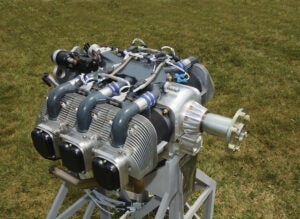
Defying the odds that new engines can’t be successfully brought to market, ULPower continues to invest in its line of mechanically conservative, electronically contemporary engines. Last year the consortium of Belgian industrial firms forming ULPower turbo-normalized their largest six-cylinder; this year they moved from cast to forged pistons across their lineup.
Definitely growing in popularity, that lineup is built around one air-cooled cylinder design and either a standard or long-stroke crankshaft. Arranging the number of cylinders and strokes, along with aerobatic oiling mods and a helicopter variant, has yielded 16 engines arranged in four basic engine families. This gives a surprisingly wide range of displacement and power options ranging from 97 to 220 hp.
The turbo-normalized 220-hp six-cylinder introduced last year continues to headline ULPower’s offerings. The prototype turbo engine was flying in an RV-4 in 2021 and has since gained an electrically adjustable 4-blade Airmaster propeller to fully capitalize on the power available at altitude. ASTM certification has also been obtained for this engine, making it available for use on European certified airframes, and ASTM certification is also underway for the 118- and 130-hp non-turbo engines as well.
A relatively new company by aviation standards—the first ULPower engine was built in 2002 and the company legally formed in 2006—it does beg the question of how many fleet hours have been logged. We don’t have a definite number of ULPower engines flying in the U.S., but judging from the enthusiastic following on ULPower’s Facebook page and anecdotal reports, the engines are well established in the light plane field and interest is growing in the RV ranks. In any case, ULPower lists a TBO of 12 years or 1500 hours.
A measure of the RV interest is the U.S. distributor, Robert Helms, has had his firewall-forward specialist develop a Lycoming Dynafocal adapter mount. This is a tube weldment sandwiched between the ULPower engine’s Jabiru-based engine mounting plate and a standard RV-6 engine mount; it adds the necessary four inches or so required to balance the lighter Belgian engine under the stock RV cowl.
To offer a general description of the ULPower engines, they’re an interesting combination of traditional horizontally opposed, single camshaft, pushrod activated overhead valve, air cooled, direct drive layout with electronic engine management as all are electronically fuel injected and sparked. Thus, there is no mechanical fuel pump. A single computer is stock, but dual ECUs are optional. Dual electronic ignition is standard, and a steady supply of electrons is mandatory as demand is 21 amps running and 50 amps of charging. These engines also run more cleanly on 93 octane unleaded gasoline, but many owners run 100LL due to availability.
Pricing was raised between 2 and 3% last year, but the dollar exchange rate also moved (favorably) in 2021, erasing the price gain for U.S. buyers. In this guide we’re following ULPower’s guidance to simply run last year’s prices in dollars, but as always, ULPower pricing is dependent on the euro to dollar exchange rate, so watching the market and planning well ahead is good advice here.
| Manufacturer/Model | Drive Type | Horsepower | Weight | Price |
|---|---|---|---|---|
| AC-Aero USA LLC | ||||
| LEGION 409 | direct | 228 hp | 290 lb w/o fuel system, starter, ign. | $58,850 |
| LEGION 440 | direct | 250 hp | 325 lb w/o fuel system, starter, ign. | $69,850 |
| LEGION 613 | direct | 342 hp | 400 lb w/o fuel system, starter, ign. | $87,350 |
| LEGION 660 | direct | 375 hp | 440 lb w/o fuel system, starter, ign. | $97,650 |
| GLADIATOR 344 | direct | 200 hp | TBD | $54,350 |
| GLADIATOR 390 | direct | 220 hp | TBD | $55,850 |
| CENTURION 583 | direct | 350 hp | TBD | $82,850 |
| GLADIATOR X-440 | direct | 275 hp | TBD | $70,920 |
| CENTURION X-660 | direct | 415 hp | TBD | $103,460 |
| GLADIATOR RS-440 | direct | customer specific | customer specific | $100,000+ |
| CENTURION RS-660 | direct | customer specific | customer specific | $150,000+ |
| BRP Rotax | ||||
| 912 UL | geared | 80 hp @ 5800 rpm, carbureted | 130 lb w/ exhaust, internal alternator | $17,258 |
| 912 ULS | geared | 100 hp @ 5800 rpm, carbureted | 137 lb w/ exhaust, internal alternator | $20,585 |
| 912 iS | geared | 100 hp @ 5800 rpm, EFI | 155 lb w/ exhaust, internal alternator | $23,754 |
| 914 UL | geared | 115 hp @ 5800 rpm, carbureted, turbo | 155 lb w/ exhaust, internal alternator | $33,737 |
| 915 iS | geared | 135 hp @ 5800 rpm, EFI, turbo, intercooled | 185 lb bare, aprox 245 lb installed | $40,353 |
| Continental Motors/ Titan | ||||
| OX-340-BDJ2T8H | direct | 174 hp, carbureted, light fixed pitch crank | 253 lb, w/ P-mags, fuel system, starter, mag sump | $35,689 |
| OX-340-BDJ3T8H | direct | 180 hp, carbureted, light fixed pitch crank | 253 lb, w/ P-mags, fuel system, starter, mag sump | $35,675 |
| OX-340-JDD3T8H | direct | 180 hp, carbureted, solid flange crank | 257 lb, w/ P-mags, fuel system, starter, mag sump | $35,867 |
| OX-340-JDE2T8H | direct | 174 hp, carbureted, solid flange crank | 257 lb, w/ P-mags, fuel system, starter, mag sump | $35,962 |
| IOX-340-BDD3T8H | direct | 180 hp, injected, light fixed pitch crank | 261 lb, w/ P-mags, fuel system, starter, mag sump | $41,319 |
| IOX-340-JDD3T8H | direct | 180 hp, injected, solid flange crank | 273 lb, w/ P-mags, fuel system, starter, mag sump | $40,870 |
| IOX-340-JDE3T8H | direct | 180 hp, injected, solid flange crank | 250 lb, w/ Lightspeed, fuel system, starter, mag sump | $40,942 |
| OX-370-ADD7T8H | direct | 187 hp, carbureted, constant speed | 265 lb, w/ P-mags, fuel system, starter, mag sump | $37,423 |
| OX-370-JDD7T8H | direct | 187 hp, carbureted, fixed pitch | 260 lb, w/ P-mags, fuel system, starter, mag sump | $36,534 |
| IOX-370-CDB1T8C | direct | 195 hp, injected, CS, counterweighted | 287 lb, w/ mags, fuel system, starter, cold air sump | $43,091 |
| IOX-370-CDB1T8H | direct | 195 hp, injected, CS, counterweighted | 268 lb, w/ mags, fuel system, starter, mag sump | $41,915 |
| IOX-370-CDD1T8C | direct | 195 hp, injected, CS, counterweighted | 284 lb, w/ P-mags, fuel system, starter, cold air sump | $44,658 |
| IOX-370-CDD1T8H | direct | 195 hp, injected, CS, counterweighted | 268 lb, w/ P-mags, fuel system, starter, mag sump | $43,483 |
| IOX-370-CLD1T8C | direct | 195 hp, injected, CS, counterweighted, front gov | 287 lb, w/ P-mags, fuel system, starter, cold air sump | $45,331 |
| IOX-370-CLD1T8H | direct | 195 hp, injected, CS, counterweighted, front gov | 273 lb, w/ P-mags, fuel system, starter, mag sump | $44,632 |
| IOX-370-RDD1T8H | direct | 195 hp, injected, fixed pitch, counterweighted | 275 lb, w/ P-mags, fuel system, starter, mag sump | $43,514 |
| D-Motor and d-motor-usa.com | ||||
| LF26 2690cc 4-cyl | direct | 92 hp @ 3000 rpm | 137 lb w/ alternator, starter, dual ECU, exhaust, fluids | $30,000 est. |
| LF39 3993cc 6-cyl | direct | 125 hp @ 3000 rpm | 184 lb w/ alternator, starter, dual ECU, exhaust, fluids | $64,673 |
| Edge Performance | ||||
| EP915ECi | geared | 120 hp @ 5800 rpm | 125 lb | $31,900 |
| EP914Ti | geared | 126 hp @ 5800 rpm | 150 lb | $33,900 |
| EP912STi | geared | 154 hp @ 5800 rpm | 150 lb | $39,500 |
| HKS Co. Ltd and quicksilverne.com | ||||
| 700E Twin | geared | 60 hp @ 6200 rpm (3 min), 56 @ 5800 rpm continuous | 121 lb w/ carburetors, fuel pump, dual CDI | $13,656 w/ exhaust, oil tank/cooler |
| Jabiru AU and flylightning.net | ||||
| Generation 4 2200 (4-cyl) | direct | 85 hp @ 3300 rpm | 136 lb w/ exhaust, carb, starter, alternator, ignition | $15,900 |
| Generation 4 3300 (6-cyl) | direct | 120 hp @ 3300 rpm | 184 lb w/ exhaust, carb, starter, alternator, ignition | $19,900 |
| Lycoming | *S= Standard, T= Thunderbolt |
|||
| YO-235-EXP | direct | 118 hp @ 2800 rpm, carburetor, parallel valve | 250 lb w/ mags, fuel system, starter | $31,300 (S) $35,300 (T) |
| YO-320-D1A | direct | 160 hp @ 2700 rpm, carburetor, parallel valve | 255 lb w/ mags, fuel system, starter, CS | $33,000 (S) $37,000 (T) |
| YIO-320-DIA | direct | 160 hp @ 2700 rpm, injected, parallel valve | 270 lb w/ mags, fuel system, starter | $36,000 (S) $40,000 (T) |
| YO-360-A1A | direct | 180 hp @ 2700 rpm, carburetor, parallel valve | 285 lb w/ mags, fuel system, starter | $33,000 (S) $37,000 (T) |
| YO-360-A4M | direct | 180 hp @ 2700 rpm, carburetor, parallel valve | 285 lb w/ mags, fuel system, starter | $32,500 (S) $36,500 (T) |
| YIO-360-M1B | direct | 180 hp @ 2700 rpm, injected, parallel valve | 290 lb w/ mags, fuel system, starter | $35,250 (S) $39,250 (T) |
| YIO-360-A1B6 | direct | 200 hp @ 2700 rpm, injected, angle valve | 325 lb w/ mags, fuel system, starter | $42,000 (S) $46,000 (T) |
| YIO-390-A3B6 | direct | 210 hp @ 2700 rpm, injected, angle valve | 315 lb w/ mags, fuel system, starter | $43,000 (S) $47,000 (T) |
| YIO-390-EXP119 | direct | 215 hp @ 2700 rpm, injected, angle valve | 315 lb w/ mags, fuel system, starter | $45,500 (S) $49,500 (T) |
| YIO-540-D4A5 | direct | 260 hp @ 2700 rpm, injected, parallel valve | 400 lb w/ mags, fuel system, starter | $55,600 (S) $59,600 (T) |
| YIO-540-EXP 9:1, 10:1 Cold Air Induction | direct | 285-300 hp @ 2700 rpm, injected, parallel valve | 400 lb w/ mags, fuel system, starter | NA |
| YIO-580-B1A | direct | 315 hp @ 2700 rpm, injected, angle valve | 440 lb w/ mags, fuel system, starter | $73,200 (S) $77,200 (T) |
| MWfly | ||||
| Spirit 100 Direct Drive | direct | 100 hp @ 3400 rpm | 163 lb dry, no accessories | $18,690 |
| Spirit 115 Direct Drive | direct | 115 hp @ 3350 rpm | 163 lb dry, no accessories | $21,026 |
| Spirit 122 Geared PSRU | geared | 122 hp @ 4000 rpm | 174 lb dry, no accessories | $22,194 |
| Spirit 135 Geared PSRU (helicopter only) | geared | 135 hp @ 4550 rpm | 174 lb dry, no accessories | $25,699 |
| Spirit 135 Direct Drive | direct | 135 hp @ 4550 rpm | 163 lb dry, no accessories | $28,035 |
| Spirit 160 Direct Drive (helicopter only) | direct | 160 hp @ 4650 rpm | 163 lb dry, no accessories | $31,539 |
| Spirit 140 Geared PSRU | geared | 140 hp @ 4050 rpm | 174 lb dry, no accessories | $28,035 |
| Spirit 160 Geared PSRU | geared | 160 hp @ 4650 rpm | 174 lb dry, no accessories | $31,539 |
| Superior Air Parts | ||||
| XP-O-320-A1AC2 | direct | 160 hp, carb, fixed pitch | 285-290 lb w/ mags, fuel system, starter | $26,300 |
| XP-IO-320-A1AC2 | direct | 165 hp, injected, fixed pitch | 285-290 lb w/ mags, fuel system, starter | $27,100 |
| XP-O-360-A1AC2 | direct | 180 hp, carb, fixed pitch | 288-297 lb w/ mags, fuel system, starter | $26,300 |
| XP-IO-360-A1AC2 | direct | 185 hp, injected, fixed pitch | 288-297 lb w/ mags, fuel system, starter | $27,100 |
| XP-O-320-B1AC2 | direct | 160 hp, carb, constant speed | 285-290 lb w/ mags, fuel system, starter | $26,600 |
| XP-IO-320-B1AC2 | direct | 165 hp, injected, constant speed | 285-290 lb w/ mags, fuel system, starter | $27,400 |
| XP-O-360-B1AC2 | direct | 180 hp, injected, constant speed | 288-297 lb w/ mags, fuel system, starter | $26,600 |
| XP-IO-360-B1AC2 | direct | 185 hp, injected, constant speed | 288-297 lb w/ mags, fuel system, starter | $27,400 |
| XP-IO-382-J1AD9 | direct | 200 hp, injected, counterweighted crank | 282 lb w/ mags, fuel system, starter | $32,500 |
| XP-IO-400-J1AD9 | direct | 215 hp, injected, counterweighted crank | 283 lb w/ mags, fuel system, starter | $34,500 |
| ULPower | ||||
| UL260i 4-cyl | direct | 97 hp @ 3300 rpm / 82 hp @ 2800 rpm | 159 lb w/ accessories, oil and exhaust | $20,000 |
| UL260is 4-cyl | direct | 107 hp @ 3300 rpm | 159 lb w/ accessories, oil and exhaust | $21,000 |
| UL350i 4-cyl | direct | 118 hp @ 3300 rpm | 173 lb w/ accessories, oil and exhaust | $23,000 |
| UL350iS 4-cyl | direct | 130 hp @ 3300 rpm | 173 lb w/ accessories, oil and exhaust | $24,000 |
| UL390i 6-cyl | direct | 140 hp @ 3200 rpm / 130 hp @ 2800 rpm | 220 lb w/ accessories, oil and exhaust | $29,000 |
| UL390iS 6-cyl | direct | 160 hp @ 3200 rpm / 140 hp @ 2800 rpm | 220 lb w/ accessories, oil and exhaust | $30,000 |
| UL520i 6-cyl | direct | 180 hp @ 3200 rpm / 169 hp @ 2800 rpm | 238 lb w/ accessories, oil and exhaust | $31,500 |
| UL520iS 6-cyl | direct | 200 hp @ 3200 rpm / 182 hp @ 2800 rpm | 238 lb w/ accessories, oil and exhaust | $32,500 |














One correction for you, the HKS 700E is a 4-cycle engine. Your description implies its a 2-cycle.
Data sheet excludes UL Power’s 520 Turbo variant that’s discussed in the article portion
I would still list the Yamaha Apex models under Edge Performance. They have a complete engine offering, and specs are quite competitive. Now having to perform this comparison myself.